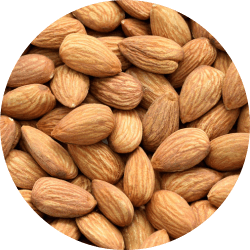Whether you suffer from digestive issues from consuming gluten or just simply trying to reduce your carbohydrate intake, you may find yourself seeking alternatives to traditional wheat-based flours. Fortunately we live in a world with plentiful substitutes to wheat flour, two of which are peanut flour and almond flour. In this post we’ll be doing a complete comparison of peanut flour vs almond flour in terms of nutrition and how well they work as a flour substitute.
Peanut Flour

Peanut flour is made from crushed peanuts where most (or all) of the fat has been removed. Because of this, it’s very high in protein relative to its caloric content. A half cup serving of peanuts contains roughly 36 grams of fat. By removing the fat you can reap the nutritional benefits of consuming peanuts without having to add too much to your fat calories.
Generally speaking, there’s two different types of peanut flour to consider…
- Light roast: light roast peanut flour is made from light roast peanuts and tends to have the faintest amount of peanut flavor and aroma. It’s typically used as an ingredient in dishes where no added flavor is needed.
- Dark roast: much like the light roast variation, dark roast peanut flour is made of dark roast peanuts, but it tends to have more of a rich, peanut flavor and aroma, and is typically used as an ingredient in dishes where some added peanut flavor is needed.
What Peanut Flour Is Used For
Peanut flour has many uses. Here are just a few of the many instances in which peanut flour can come in handy.
Gluten-free flour substitute for baking
Peanut flour is a great substitute for traditional white flour if you’re looking to avoid gluten and if you’re aiming to keep your carbohydrates as low as possible. It has 11.7 less grams of carbohydrates per 28 gram servings than white flour does, and not to mention 11.7 more grams of protein, and nearly half the calories!
Low-fat alternative to peanut butter
Most grocery stores have jars and packages of dried peanut powder alongside other peanut butter products on their shelves. Mixing them with a little bit of water can produce a lower fat alternative to traditional peanut butter, which can contain as much as 16 grams of fat for ever 2 tablespoon serving.
It should be pointed out though that some brands of peanut powder have added ingredients like sugar and salt, so be sure to check the nutrition label before purchasing.
Plant-based protein smoothies
Peanut flour can also work well as an ingredient for smoothies. A 28 gram serving contains 10 grams of protein, making it a great way to sneak some plant-powered protein (along with some rich, nutty flavor) into your blended drinks.
Toppings
Finally, peanut flour can be used as a topping when you want to add some flavor, protein, and fiber to things like cereals, oatmeal, desserts, and more. It can also help thicken the consistency of whatever it is you’re eating.
Almond Flour

Almond flour is made of crushed almonds that have had the skin removed. Unlike peanut flour, the fat is typically not removed from almond flour.
When making almond flour, the almonds are boiled in order to remove the skin (this is called blanching,) and then they are dried and grounded to a fine powder.
Almond flour should not be confused with almond meal. The primary difference is that almond meal is made from crushed almonds that still have the skin intact, whereas almond flour is made without the skin, giving it a finer texture.
What Almond Flour Is Used For
Almond flour is primarily used as a substitute for wheat-based flours when baking various baked goods, including…
- Pastries
- Breads
- Pie crusts
- Pancakes
- Waffles
- Biscuits
- Cookies
- Macarons
Compared to a 28 gram serving of white flour, almond flower has 15.8 less grams of carbohydrates, 3.2 more grams of protein, and less than half the calories. This makes almond flour an excellent alternative for those with gluten sensitivities and anyone looking to reduce carbohydrates in their diets.
It should be noted though that almond flour does contain significantly more fat than white flower does, meaning it’ll add some moisture to your recipes.

Another reason you may want to bake with almond flour is that it can complement your baked goods with a rich, nutty taste and aroma.
Peanut Flour VS Almond Flour
Let’s take a look at how things stack up for peanut flour vs almond flour as far as nutrition facts go.
Nutrition
| Flour type per 28g | Calories | Total fat (g) | Carbohydrates (g) | Protein (g) | Fiber (g) |
| Peanut flour | 91.6 | 0.2 | 9.7 | 14.6 | 4.4 |
| Almond flour | 163 | 14.2 | 5.6 | 6.1 | 3 |
| White flour | 102 | 0.3 | 21.4 | 2.9 | 0.8 |
As you can see in the nutritional data above, both peanut flour and almond flour would both be great alternatives to white flour. They both have significantly less carbohydrates, but much more dietary fiber.
As far as peanut flour vs almond flour goes, peanut flour has roughly 40% less calories per serving, significantly less fat, more than double the protein, but it does have roughly 40% more carbohydrates.
Peanut flour would be ideal if you’re seeking a lower-fat flour alternative with fewer calories and more protein. Almond flour would be ideal if you’re looking to keep your carbohydrate intake as low as possible, even if it means having to consume more calories and fat.
Taste
The difference in taste between peanut flour vs almond flour is negligible. They can both add a rich, nutty flavor and aroma to your dishes. Almond flour has more fat though, so it can add some moisture and enhance the flavor of your recipes as well.
The nutty flavor in peanut flour, as you would imagine, taste more like peanuts when compared to almond flour. This is an important consideration if you’re using it for baking.
How They Work As A Flour Substitute

Let’s take a look at the differences between peanut flour vs almond flour when it comes to baking, cooking, and substituting with traditional white flour.
Peanut Flour
Peanut flour can be used at a 1:1 substitute ratio for white flour. However, it will add a peanut flavor to whatever it is you’re using it in. If you’d rather not have that added flavor then it may be ideal to seek a more neutral alternative.
Almond Flour
Almond flour can be used as a 1:1 substitute to white flour, according to a contributor to MOMables. They also note that you may need to use additional binding agents, like eggs, so this could affect your recipe.
Conclusion
Both peanut and almond flour can serve as a nutritious, gluten-free and low-carb substitute for white flour. They will both add more protein and fiber, but contain less carbohydrates.
The conclusive takeaway when comparing peanut flour versus almond four is that almond flour is more suitable for a low-carb diet, whereas peanut flour would be ideal if you’re looking to add some more plant-based protein to your diet.
When baking, they both add a rich, nutty flavor and aroma to your recipes, but may requite additional binding agents as compared to white flour.

